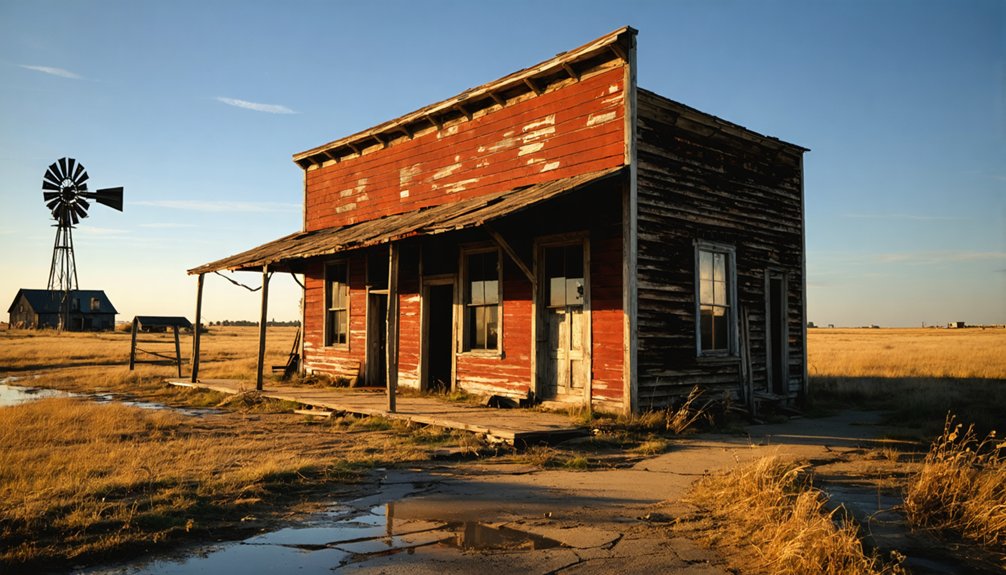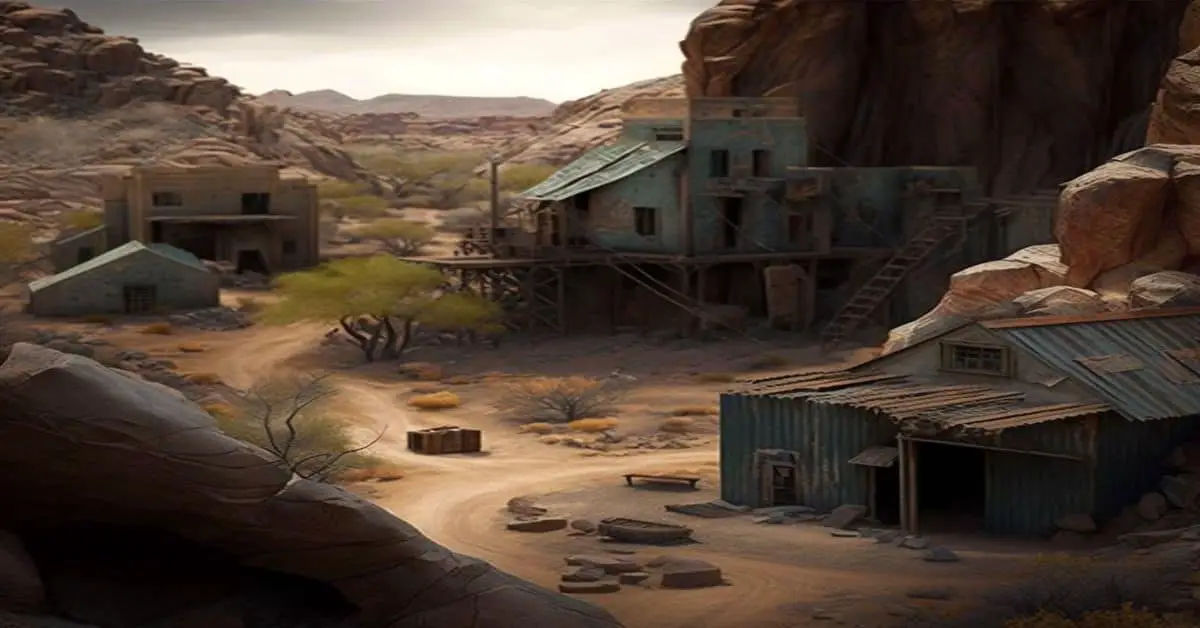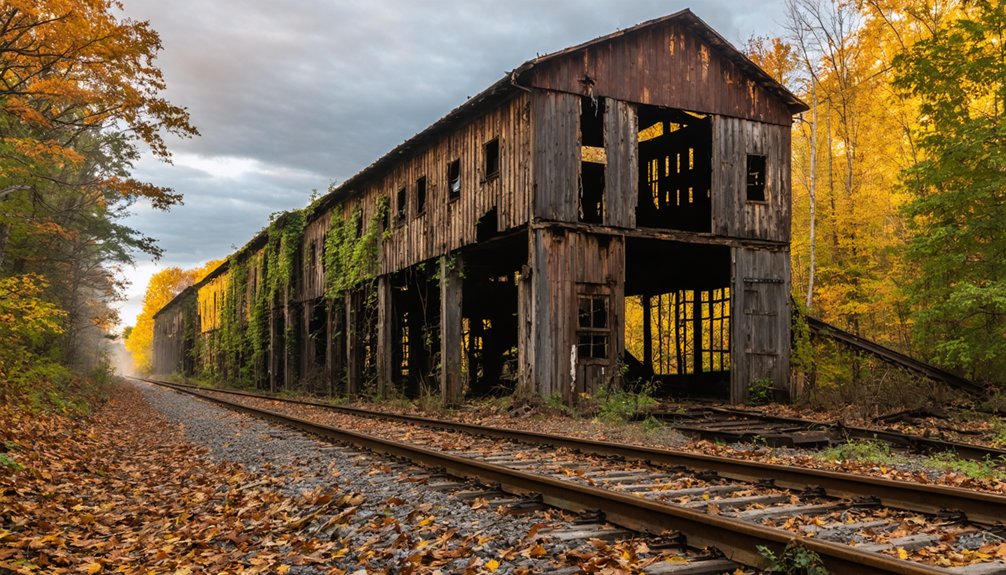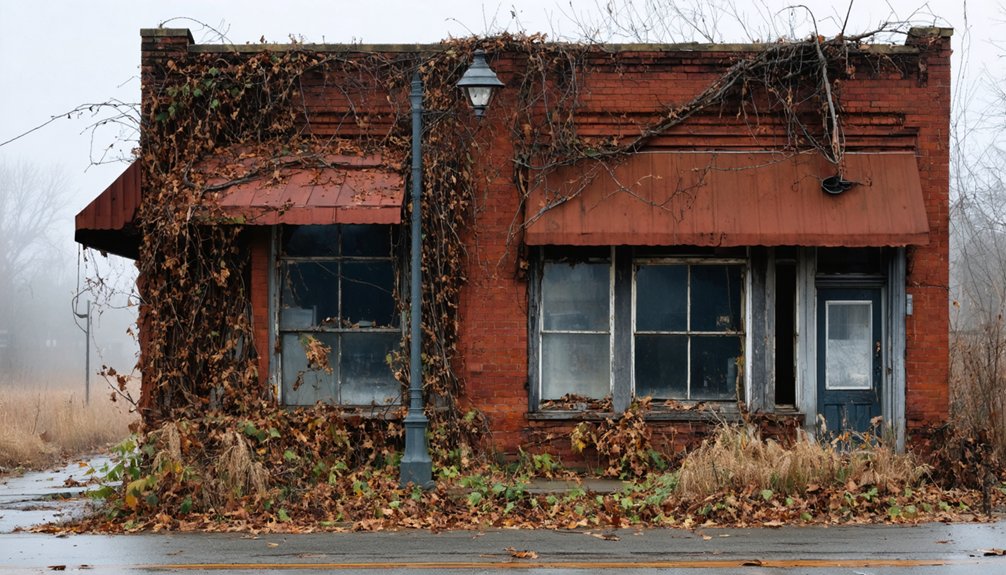You’ll find Granville, Indiana as a ghost town today, but it began as a thriving canal settlement in 1834 along the Wabash and Erie Canal near the former Native American village of Ouiatenon. The founders laid out 153 lots around a public square, establishing essential businesses like a post office, general store, and sawmill. While the town prospered initially, railroad competition led to its decline by 1878. The remnants of this once-bustling community tell a fascinating story of frontier ambition and change.
Key Takeaways
- Established in 1834 along the Wabash and Erie Canal, Granville was a bustling town that later became one of Indiana’s notable ghost towns.
- The town featured 153 lots around a public square, with essential businesses including a post office, general store, and sawmill.
- Railroad competition led to Granville’s economic decline by 1878, contributing significantly to its eventual ghost town status.
- Originally named Granville and later renamed Weaton, the town served as a vital transportation and commerce hub along the Mississinewa River.
- Today, Granville Cemetery remains as one of the few visible remnants of this once-thriving community in Delaware County, Indiana.
The Birth of a Frontier Settlement
As pioneers pushed westward into the Indiana Territory, Thomas W. Treckett and Thomas Concannon envisioned a thriving community along the Wabash and Erie Canal. In 1834, they established Granville where frontier challenges met opportunity, carefully selecting a location near the former Native American settlement of Ouiatenon. Shortages of supplies were a constant concern for the early settlers, mirroring challenges faced by other frontier outposts.
You’ll find the settlement dynamics of early Granville reflected in its thoughtful design – 153 lots arranged around a public square, with streets named for notable figures and landmarks. Like Fort Granville’s blockhouses, the town incorporated defensive features to protect its residents from potential threats.
The town’s strategic position made it a crucial shipping center, capitalizing on the canal’s bustling trade routes. While the Wea Indians had been relocated west of the Mississippi, their influence remained strong enough that by 1850, settlers renamed the town Weaton, preserving a connection to the area’s indigenous heritage.
Location and Geographic Features
You’ll find Granville perched strategically along the banks of the Mississinewa River, where early settlers recognized the waterway’s importance for both transportation and commerce.
The community took root at the crossroads of what’s now CR 877N and 375E in Niles Township, Delaware County, making it an accessible hub for surrounding farms and homesteads.
The settlement’s position at the township border helped establish it as a natural gathering point for locals from multiple jurisdictions, contributing to its early growth as a frontier outpost.
Like many towns from the early 19th century, the community’s development was shaped by the establishment of mills and trading posts that served the growing population.
Similar to its Ohio namesake founded in 1805, this Granville settlement featured a prominent stagecoach inn that served travelers passing through the region.
River Settlement Origins
When settlers established Granville in 1834, they strategically chose a location on the south side of the Wabash and Erie Canal near the Wabash River’s south bank, approximately 550 feet above sea level.
The site’s selection wasn’t random – it had been a hub of cultural exchange for generations, previously home to the Native American settlement of Ouiatenon.
The town’s founders recognized the potential for river trade, positioning Granville as a crucial shipping hub where commerce could flourish. The rich loam and clay soil along the river provided excellent conditions for early agriculture.
You’ll find it interesting that some early residents even floated their buildings downstream from rival towns to resettle in this promising location.
The convergence of the canal and river created ideal conditions for growth, though this dependence on water transport would later contribute to the town’s vulnerability when transportation methods evolved.
To avoid confusion with other locations named Granville, historical records often include place name disambiguation to distinguish this Indiana settlement from similarly named towns.
Township Border Location
Located in Wayne Township of Tippecanoe County, Granville once thrived at coordinates 40°24′25″ N, 87°01′53″ W, not far west of Lafayette and near present-day Shadeland.
Much like small town life depicted in British television, the town’s geographic significance stems from its position along the Wabash River at an elevation of 550 feet, where you’ll still find a bridge bearing the Granville name.
The township history reveals how this strategic location supported Granville’s role as a crucial shipping center on the Wabash and Erie Canal.
While the original 153-lot layout included streets named Lafayette, Cherry, Wabash, and Washington, today you’ll find only scattered remnants of the town.
A historical marker and cemetery east of the former settlement preserve the memory of this once-bustling community, now serviced by West Point’s postal system.
Early Pioneers and Native American Relations
You’ll find evidence of the Wea tribe‘s significant presence in the area through their village of Ouiatenon, which predated Granville‘s establishment and served as an important regional trading post.
When Thomas W. Treckett and Thomas Concannon founded Granville in 1834, they built near the former Native American settlement, maintaining peaceful relations with remaining Wea families who hadn’t yet relocated west of the Mississippi.
The town’s brief renaming to Weaton in 1850 reflected local settlers’ respect for the Wea people’s heritage, though by then most tribal members had moved downstream due to federal removal policies. Like many settlements of that era, the founders established Granville near a clean water source that sustained both Native American and pioneer communities.
Wea Tribe Settlement Patterns
Throughout the early 18th century, the Wea tribe established a significant presence along Indiana’s Wabash River, creating a network of villages that stretched from present-day Terre Haute to Logansport.
You’ll find their most important settlement, Ouiatenon, was strategically positioned near today’s Lafayette, where they maintained extensive cornfields and developed strong trade relations with French settlers. This settlement became a major trading hub for French merchants operating in the region.
The Wea’s agricultural lifestyle centered around seasonal patterns, with summer villages flourishing near Wea Creek for over 70 years.
By 1718, you’d have seen five distinct villages clustered around Fort Ouiatenon, showcasing their close ties to French trading posts. Their population reached approximately twelve hundred people by 1765.
However, ongoing pressures led to significant Wea migrations, including their eventual move to Illinois and Missouri in 1820, after selling their remaining Indiana lands near Raccoon Creek.
Peaceful Settler Interactions
When early European settlers arrived in the Granville area around 1800, they encountered remaining Native American groups, primarily the Wyandotte near Johnstown in Monroe Township.
While tensions existed, some periods of peaceful coexistence emerged through cultural exchange and strategic alliances.
- Marriage bonds formed between settlers and Native individuals, creating unique family connections
- Both groups shared established Native trails, especially the Buffalo Trace
- Trading activities occurred at adjacent settlement boundaries
- Native camps remained within Granville Township’s borders for several years
- Some settlers learned indigenous farming and hunting techniques
The Treaty of Greenville in 1795 had established official boundaries, though they weren’t always respected.
Despite building defensive blockhouses, many settlers engaged in limited but meaningful interactions with Native Americans before the tribes gradually relocated due to increasing land pressures.
Relocating Communities Downstream
During the 1830s, early settlers from Georgeville and other nearby communities migrated downstream to Granville, drawn by the promise of a more centralized and prosperous settlement along the Wabash and Erie Canal.
You’ll find that this downstream migration created significant changes in the region’s settlement patterns, as smaller upstream communities declined while Granville grew into a bustling hub.
The community consolidation wasn’t easy for these pioneers. They’d to transport their belongings along rivers and canals, rebuild their homes, and establish new social connections.
While the move disrupted established networks and local governance structures, settlers believed the economic advantages of living near major transportation routes would outweigh these challenges.
The canal provided essential access for shipping goods and connecting with other settlements, making Granville an attractive destination for those seeking better opportunities.
Business and Commerce in Granville’s Heyday
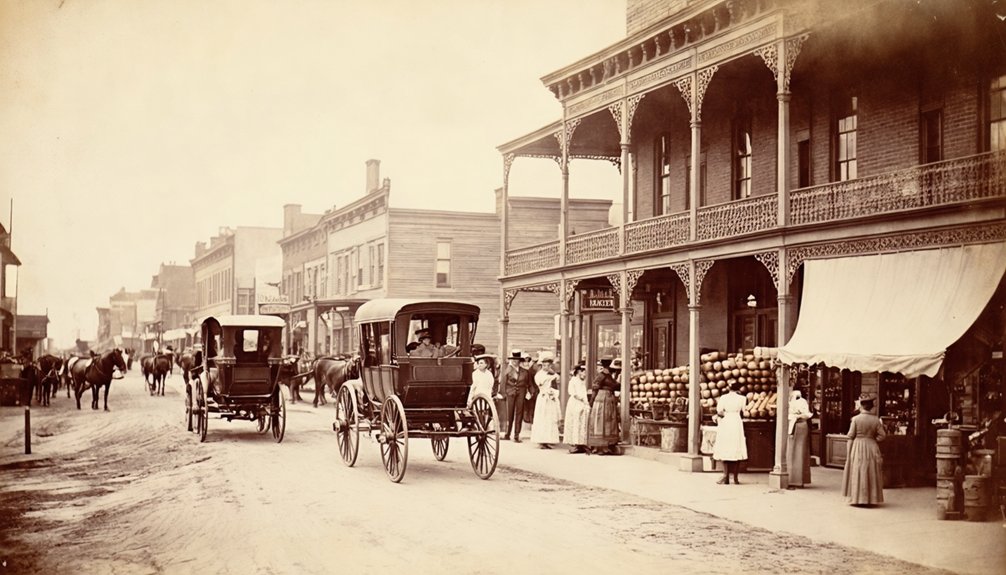
As Granville emerged alongside the Wabash and Erie Canal in 1834, the town quickly established itself as an essential shipping and commerce hub.
The bustling canal commerce attracted merchants and fostered a vibrant trading community until the mid-1850s. You’d have found these essential businesses serving the community:
- A central post office managing mail from 1840 to 1901
- A general store and grocery supplying daily necessities
- A busy blacksmith shop serving local needs
- A productive sawmill supporting construction
- An active Masonic Lodge fostering community ties
The town’s strategic layout, with its public square and network of streets named Lafayette, Cherry, Wabash, and Washington, supported thriving commercial activities.
However, when railroad competition intensified, shipping activity declined sharply, leading to Granville’s economic downturn by 1878.
Community Life and Social Institutions
Life in Granville centered around a rich tapestry of social institutions that shaped daily community interactions. The Masonic Lodge served as a hub for fraternal bonding and civic leadership, while the public square hosted community gatherings and celebrations.
You’d find religious life thriving through the Swedish church congregation and nearby Quaker meeting house, where worship and education intertwined.
The town’s social cohesion was strengthened through shared spaces and activities. Children attended the local school, while adults participated in lodge meetings and civic events.
The Granville Cemetery, still standing east of town, reflects the community’s dedication to preserving family and cultural ties. These institutions fostered a tight-knit society where neighbors supported one another through both celebrations and hardships.
The Slow Fade: Factors Behind Abandonment
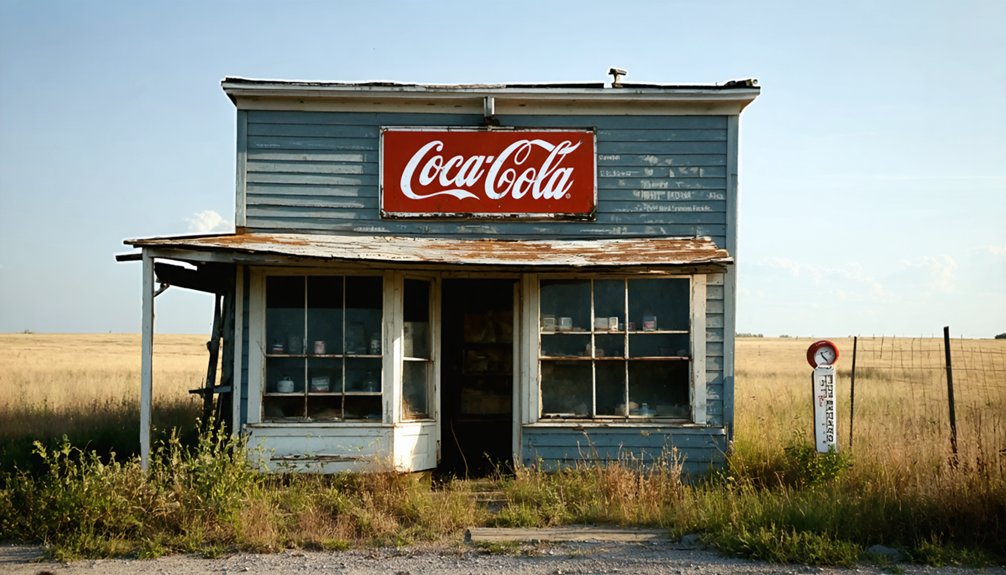
The vibrant social fabric that once defined Granville began to unravel in the mid-1800s through a complex web of economic and technological changes.
Like a fraying tapestry, Granville’s vibrant community spirit slowly dissolved amid sweeping changes of the Industrial Revolution.
You’ll find that transportation evolution played a decisive role, as the town’s lifeline – the Wabash and Erie Canal – lost its significance to emerging railroad networks that bypassed the community entirely.
- Empty storefronts where merchants once traded goods
- Abandoned homes with weathered wooden porches
- Overgrown lots where children previously played
- Crumbling canal infrastructure, now silent and still
- Vacant community gathering spaces reclaimed by nature
These economic transformations weren’t just about business – they transformed the very heart of Granville.
As younger residents sought opportunities elsewhere, the town’s population steadily declined.
Without rail connections or new industries to sustain growth, Granville’s destiny was sealed by forces beyond its control.
What Remains: Physical Traces Today
While decades have passed since Granville’s bustling days, several physical traces of this once-thriving community still dot the landscape today.
You’ll find remnants of old roads, including Country Road 750 S and Sleeper Road, winding through the area. A newly paneled house stands as a symbol of the past, though the Naylor family’s salt house and barn are now gone.
The Farmer’s Institute, once a school and meeting house, continues to serve the community, while the Quaker meeting house remains active for worship.
The Granville cemetery endures as one of the most significant historical preservation sites, and the land holds potential for future archaeological discoveries.
Though many structures have yielded to time and nature, these remaining landmarks help preserve the story of this Indiana ghost town.
Legacy in Indiana’s Historical Record
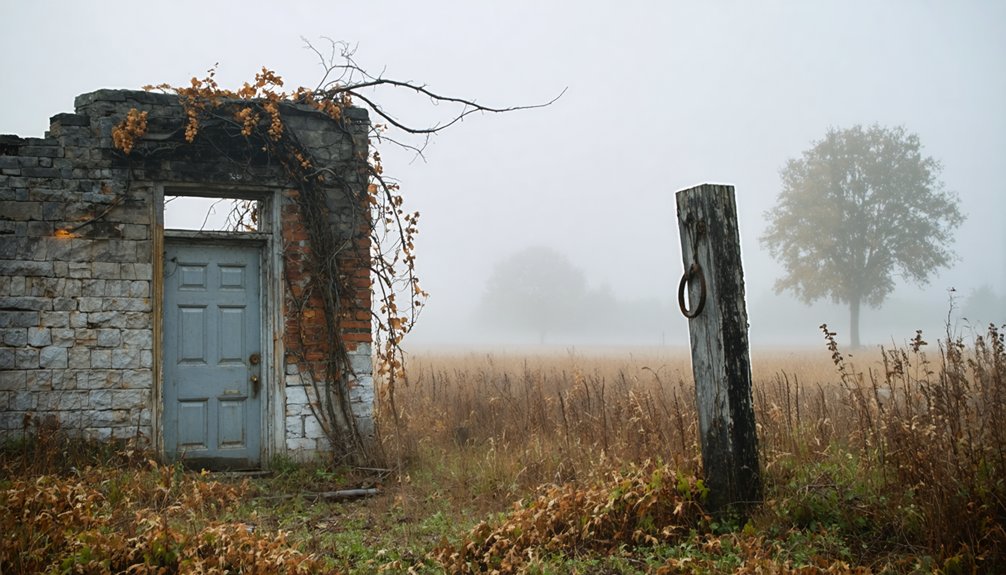
Founded in 1834 along the Wabash and Erie Canal, Granville stands as a tribute to Indiana’s dynamic canal-era development and settlement patterns.
Granville’s birth in 1834 marks a pivotal moment in Indiana’s canal history, representing an era of ambitious waterway expansion.
You’ll find Granville’s heritage preserved in historical records that showcase its transformation from a bustling canal town to a ghost town within half a century.
The town’s cultural significance lives on through:
- The lasting presence of Granville Cemetery and Bridge
- Its brief name change to Weaton in 1850, honoring the Wea Indians
- The original 153-lot town layout that’s still visible on county maps
- The nearby Farmer’s Institute, a Quaker establishment from 1851
- Stories of regional migration, including settlers from Georgeville
Though Granville’s physical presence faded by 1878, its story continues to illuminate Indiana’s canal-era history and the economic shifts that shaped the state’s development.
Similar Ghost Towns in the Region
Granville’s story mirrors several other ghost towns scattered across Indiana’s landscape, each offering unique glimpses into the region’s canal and railroad era.
You’ll find similar abandoned settlements like Elizabethtown, which vanished by 1900 after the railroad bypassed it, leaving only its cemetery behind.
Summitsport’s ghost town story revolves around a failed hydraulic canal project, while Little Chicago, despite its humorous name rivalry with its Illinois namesake, dwindled to just one occupied house and a Quaker meetinghouse.
In Tippecanoe County alone, former communities like Beeville, Cleveland, and Sidney have faded into history.
These towns share common threads in their decline: railroad bypasses, canal obsolescence, and the irresistible pull of larger, better-connected cities.
Frequently Asked Questions
Were There Any Notable Crimes or Murders in Granville’s History?
While unsolved mysteries and local folklore surround many ghost towns, you won’t find documented evidence of notable crimes or murders in the town’s historical records during its brief existence.
What Happened to the Descendants of Granville’s Original Settler Families?
You won’t find clear descendant stories or family legacies, as available records don’t track what happened to the Ware, Laughlin, Warnock, Blanchard, Christwell, and Ish families after Granville’s decline.
Did Any Famous People Ever Visit or Live in Granville?
You won’t find any celebrity sightings or famous visitors in the historical records. The town’s notable figures were local pioneers and merchants like Granville Hastings, but no nationally recognized personalities ever resided there.
Were There Any Natural Disasters That Contributed to Granville’s Decline?
While no major tornadoes struck, you’ll find recurring floods damaged the critical Wabash and Erie Canal infrastructure, disrupting trade and mill operations, ultimately weakening the town’s economic foundation in the mid-1800s.
What Was the Highest Population Granville Ever Reached?
You won’t find exact population records for this settlement’s peak, though its historical significance suggests modest population growth compared to nearby towns that documented hundreds of residents.
References
- https://www.indystar.com/story/news/history/2019/10/25/indianas-ghost-towns-phantoms-past/3907908002/
- https://kids.kiddle.co/Granville
- https://www.onlyinyourstate.com/trip-ideas/indiana/ghost-town-road-trip-indiana
- http://ingenweb.org/intippecanoe/ghosttowns.htm
- http://www.robbhaasfamily.com/Places/Towns-Delaware Co
- https://en.wikipedia.org/wiki/Granville
- https://www.onlyinyourstate.com/experiences/indiana/ghost-towns-in
- https://thepennsylvaniarambler.wordpress.com/2019/05/29/the-fall-of-fort-granville/
- https://en.wikipedia.org/wiki/Fort_Granville
- https://www.granville.oh.us/history
